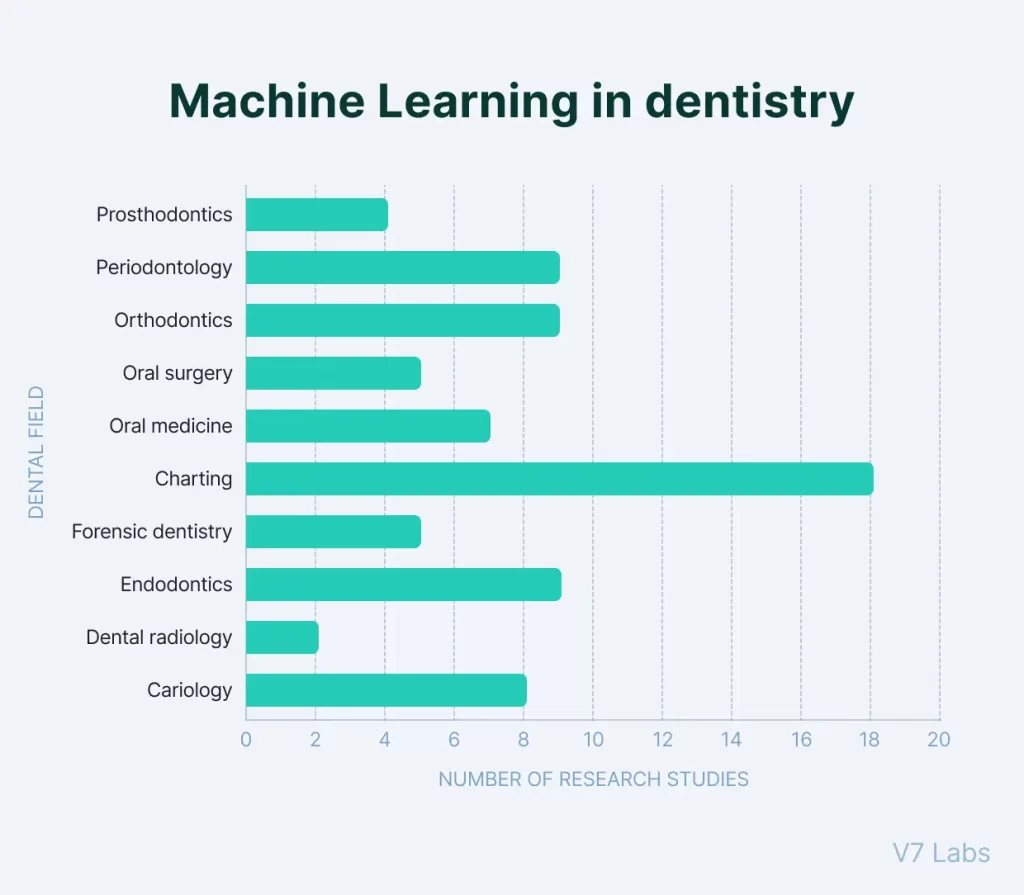The integration of Artificial Intelligence (AI) into modern healthcare has redefined diagnostics, treatment planning, and patient care. In the healthcare sector, dentistry, in particular, is undergoing a major technological evolution with AI. This evolution enhances clinical accuracy, operational efficiency, and patient outcomes.
From diagnostics to prosthetics, artificial intelligence in dentistry is becoming an indispensable part of oral healthcare systems across the globe. It is very important to know the role of Artificial intelligence in dentistry. So, continue reading to learn more about AI in dentistry.
What is Artificial Intelligence in Dentistry?
Artificial Intelligence in dentistry refers to the use of computer systems and algorithms that mimic human intelligence to analyze complex data, learn from it, and assist dental professionals in making informed decisions.
These AI systems utilize machine learning, deep learning, and natural language processing to interpret dental records, X-rays, and 3D scans to give advanced insights. They are even used to predict future dental issues.
AI-driven tools can identify minute details in imaging that are sometimes overlooked by the human eye. So, AI in dentistry provides more precise and timely diagnoses. This not only saves time but also enhances the quality of care provided to patients.
Applications of AI in Modern Dental Practice
The applications of artificial intelligence in dentistry are wide-ranging, affecting virtually every speciality within the field,
- Diagnostic Accuracy
- Predictive Analytics in Treatment Planning
- AI in Restorative Dentistry
- Artificial Intelligence in Pediatric Dentistry
Diagnostic Accuracy
One of the most significant contributions of AI in dentistry is in diagnostic imaging. AI algorithms can now detect cavities, gum diseases, oral cancers, and other dental pathologies with higher accuracy than traditional methods. Radiographs and 3D imaging can be analyzed using AI to detect issues in their early stages and help dentists provide early treatment to avoid complications.
Predictive Analytics in Treatment Planning
AI tools analyze historical patient data and clinical patterns to predict the outcome of various treatment plans. This allows dentists to create personalized treatment strategies with a high probability of success.
AI-based systems can simulate how a patient’s dental structure will evolve, which is especially helpful in orthodontics and prosthodontics.
AI in Restorative Dentistry
AI assists in designing crowns, bridges, and dentures using CAD/CAM technology in restorative dentistry. Restorations in dentistry are now more accurate, better fitting, and quicker to produce with 3D imaging and AI-driven design software. AI also aids in reducing chair time for patients by streamlining the entire workflow from diagnosis to treatment.
Artificial Intelligence in Pediatric Dentistry
Artificial intelligence in pediatric dentistry is gaining momentum as it helps address the unique challenges involved in treating young patients. Children may find it difficult to communicate symptoms or sit still during procedures. AI-powered diagnostic tools can provide fast and accurate analysis of pediatric dental X-rays, so that it helps child dentists identify issues such as early childhood caries or developmental abnormalities.
Moreover, AI-based behaviour analysis systems are being used to predict a child’s anxiety levels or discomfort, allowing pediatric dentists to adjust their approach for a more comfortable patient experience. This not only improves clinical outcomes but also fosters trust and positive dental experiences among children.
Data from V7 labs shows how much research is done in machine learning across the various dental fields. That is shown in the image below.

How AI Has Developed the Outcome of Dental Treatment
AI has significantly influenced how dental treatments are planned, executed, and followed up. Here’s how AI has developed the outcome of the dental treatment,
- Enhanced Precision
- Improved Patient Outcomes
- Streamlined Workflow
- Continuous Learning and Adaptation
- Integration with Teledentistry
Enhanced Precision
AI enables dentists to diagnose with greater precision by minimizing human errors. This leads to better-targeted treatments and reduces the likelihood of complications.
Improved Patient Outcomes
By analyzing vast datasets and clinical histories from the past, AI can help us identify trends and suggest evidence-based treatment options that have a higher probability of success. This directly contributes to improved patient satisfaction and long-term oral health.
Streamlined Workflow
AI automates time-consuming tasks such as appointment scheduling, documentation, billing, and follow-ups. This frees up more time for dentists to focus on patient care and improve overall efficiency.
Continuous Learning and Adaptation
AI continues to learn each case and every interaction so that it improves its performance and accuracy. This helps the dental centre to build an effective treatment protocol over time.
Integration with Tele dentistry
AI-powered tools facilitate remote dental consultations by providing real-time analysis of images and symptoms. This helps dentists make preliminary diagnoses without requiring the patient to visit the clinic physically — an essential feature in rural or underserved areas.
Ethical Considerations and Challenges
Even though AI has immense potential, before implementing AI at your dental centre, you need to carefully manage to address ethical and regulatory issues like data privacy, the accuracy of AI predictions, and potential over-reliance on technology.
“AI should always serve as an aid, not a replacement for professional clinical judgment.”
Dentists and dental institutions must also invest in training to understand and effectively use AI tools in clinical practice. Regulatory bodies are now working towards setting standards and guidelines for the safe use of AI in healthcare, including dentistry. This guide by WHO explains the regulatory considerations of artificial intelligence for health.
Future of AI in Dentistry
The future of artificial intelligence in dentistry looks promising with rapid advancements in deep learning and data analytics. Some future possibilities include,
- Voice-assisted charting: Hands-free documentation using AI voice assistants.
- Real-time diagnostic support: AI systems providing live feedback during dental procedures.
- Personalized oral health coaching: AI-driven mobile apps offering tailored advice and reminders based on a patient’s dental health data.
AI will become more integrated into patient care cycles, assisting dentists from the moment a patient books an appointment to the final stages of treatment and follow-up care.
Takeaway
Artificial Intelligence is not a futuristic concept in dentistry because it is already reshaping the dental landscape. AI is revolutionizing how dental care is delivered starting from enhancing diagnostic accuracy to improving treatment outcomes.
Surya Dental Care is committed to staying at the forefront of technological advancements. We aim to offer patients the most precise, effective, and compassionate dental care possible. We achieved it with the help of AI. Contact Surya Dental Care for advanced dental treatments.
FAQs
Currently, AI plays a vital role in dental diagnostics, imaging analysis, treatment planning, and workflow automation. It aids in early detection of conditions, improves orthodontic simulations, predicts treatment outcomes, and streamlines administrative tasks. AI enhances both clinical efficiency and patient care, supporting dental professionals in delivering precise and timely treatments.
AI will not fully replace dental technicians but will significantly assist them. It automates tasks like designing crowns, bridges, and aligners, improving accuracy and speed. However, the expertise and hands-on skills of technicians remain essential for customization, quality control, and complex cases that require human judgment and creativity.
Artificial intelligence is used in dentistry for diagnosing oral diseases, analyzing radiographs, planning treatments, and managing patient data. AI-powered tools help detect cavities, gum disease, and oral cancers more accurately and quickly, enhancing clinical decision-making and improving patient outcomes through early intervention and personalized care.








Leave a Comment